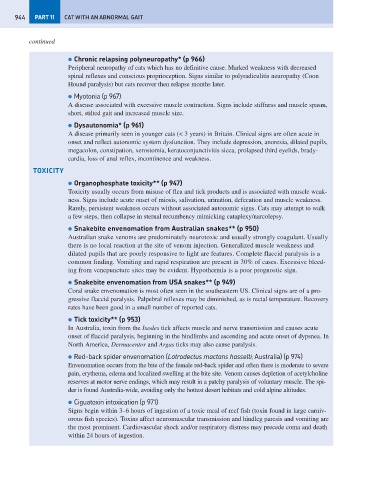Page 952 - Problem-Based Feline Medicine
P. 952
944 PART 11 CAT WITH AN ABNORMAL GAIT
continued
● Chronic relapsing polyneuropathy* (p 966)
Peripheral neuropathy of cats which has no definitive cause. Marked weakness with decreased
spinal reflexes and conscious proprioception. Signs similar to polyradiculitis neuropathy (Coon
Hound paralysis) but cats recover then relapse months later.
● Myotonia (p 967)
A disease associated with excessive muscle contraction. Signs include stiffness and muscle spasm,
short, stilted gait and increased muscle size.
● Dysautonomia* (p 961)
A disease primarily seen in younger cats (< 3 years) in Britain. Clinical signs are often acute in
onset and reflect autonomic system dysfunction. They include depression, anorexia, dilated pupils,
megacolon, constipation, xerostomia, keratoconjunctivitis sicca, prolapsed third eyelids, brady-
cardia, loss of anal reflex, incontinence and weakness.
TOXICITY
● Organophosphate toxicity** (p 947)
Toxicity usually occurs from misuse of flea and tick products and is associated with muscle weak-
ness. Signs include acute onset of miosis, salivation, urination, defecation and muscle weakness.
Rarely, persistent weakness occurs without associated autonomic signs. Cats may attempt to walk
a few steps, then collapse in sternal recumbency mimicking cataplexy/narcolepsy.
● Snakebite envenomation from Australian snakes** (p 950)
Australian snake venoms are predominately neurotoxic and usually strongly coagulant. Usually
there is no local reaction at the site of venom injection. Generalized muscle weakness and
dilated pupils that are poorly responsive to light are features. Complete flaccid paralysis is a
common finding. Vomiting and rapid respiration are present in 30% of cases. Excessive bleed-
ing from venepuncture sites may be evident. Hypothermia is a poor prognostic sign.
● Snakebite envenomation from USA snakes** (p 949)
Coral snake envenomation is most often seen in the southeastern US. Clinical signs are of a pro-
gressive flaccid paralysis. Palpebral reflexes may be diminished, as is rectal temperature. Recovery
rates have been good in a small number of reported cats.
● Tick toxicity** (p 953)
In Australia, toxin from the Ixodes tick affects muscle and nerve transmission and causes acute
onset of flaccid paralysis, beginning in the hindlimbs and ascending and acute onset of dypsnea. In
North America, Dermacentor and Argas ticks may also cause paralysis.
● Red-back spider envenomation (Latrodectus mactans hasselti; Australia) (p 974)
Envenomation occurs from the bite of the female red-back spider and often there is moderate to severe
pain, erythema, edema and localized swelling at the bite site. Venom causes depletion of acetylcholine
reserves at motor nerve endings, which may result in a patchy paralysis of voluntary muscle. The spi-
der is found Australia-wide, avoiding only the hottest desert habitats and cold alpine altitudes.
● Ciguatoxin intoxication (p 971)
Signs begin within 3–6 hours of ingestion of a toxic meal of reef fish (toxin found in large carniv-
orous fish species). Toxins affect neuromuscular transmission and hindleg paresis and vomiting are
the most prominent. Cardiovascular shock and/or respiratory distress may precede coma and death
within 24 hours of ingestion.

